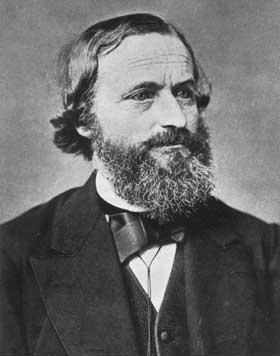Gustav Kirchhoff
claimed by fwalker2017

Gustav Kirchhoff was a German physicist who is known for his contributions to circuit laws, laws of thermal radiation, fluid dynamics equations, three laws of spectroscopy and law of thermochemistry.
Personal Life
Gustav Robert Kirchhoff was born March 12, 1824 in Kaliningrad, Russia and died 1887. He attended the Albertus University of Königsberg and graduated in 1847, accepting professorships at various universities throughout his life.During his time as a student, Kirchhoff formulated his circuit laws that are prominent in electrical engineering. During his time at University of Heidelberg, he collaborated with Robert Bunsen to study spectroscopy and they later discovered caesium and rubidium. In 1857 he calculated that an electric signal in a resistanceless wire travels along the wire at the speed of light and two years later, he proposed his law of thermal radiation. In 1862 he was awarded the Rumford Medal for his research spectroscopy, where he formalized laws that describe the spectral composition of light. He is also recognized for his solving of Maxwell’s equations which provided a basis for Huygen’s principle.
Scientific Contributions
Circuit Laws
The Current Law
Commonly referred to as the conservation of charge or node rule, the current law states that “the total current or charge entering a junction or node is exactly equal to the charge leaving the node as it has no other place to go except to leave, as nod charge is lost within the node.” Mathematically, the sum of all the current entering and leaving the nod must be equal to zero. This can be used to analyze parallel circuits. However, this law is valid only if the electric charge remains constant in the region being considered. [math]\displaystyle{ \sum {I}_{entering}+ \sum {I}_{exiting} = 0 }[/math]
Example

[math]\displaystyle{ {I}_{2} + {I}_{3} = {I}_{1} + {I}_{4} }[/math]
The Voltage Law
Commonly referred to as the conservation of energy or loop rule, the voltage law states that “in an closed loop network, the total voltage around the loop is equal to the sum of all the voltage drops within the same loop. Mathematically, the sum of all voltages within the loop must be equal to zero. This can be used to analyze series circuit.However, this law is invalid if there is a fluctuating magnetic field linking the closed loop. [math]\displaystyle{ \Delta {V}_{1} + \Delta {V}_{2} + \space.... = 0 }[/math]
Example

1. Start at any point in the loop and continue in the same direction
2. Note the direction of the voltage drops (positive or negative)
3. Continue along the loop until you reach the starting point, adding the voltages along the path.
[math]\displaystyle{ {V}_{1}+{V}_{2}+{V}_{3}={V}_{4} }[/math]


